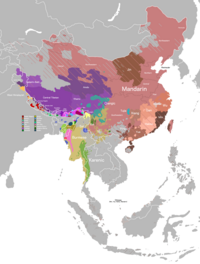Taiwanese Hakka
You can help expand this article with text translated from the corresponding article in Chinese. (February 2016) Click [show] for important translation instructions.
|
| Taiwanese Hakka | |
|---|---|
| toiˇ vanˇ hagˋ gaˊ ngiˊ / toiˇ vanˇ hagˋ fa Thòi-vàn Hak-kâ-ngî / Thòi-vàn Hak-fa | |
| Pronunciation | [tʰoi˩ van˩ hak̚˨ fa˥] [tʰoi˥ van˥ hak̚˨ fa˩] [tʰoi˧ van˩˩˧ kʰak̚˨˩ fa˥˧] [tʰoi˧ van˥ kʰak̚˥ fa˨˦] [tʰai˧ ban˥˧ kʰa˥ su˥] |
| Native to | Taiwan |
| Region | Taoyuan, Miaoli, Hsinchu, Pingtung, Kaohsiung, Taichung, Nantou, Changhua, Yunlin, Yilan, Hualien and Taitung |
| Ethnicity | Hakka Taiwanese |
Native speakers | 2,580,000 (2015)[1] |
| Dialects | |
| Latin (Pha̍k-fa-sṳ) | |
| Official status | |
Official language in | Taiwan[a] |
| Regulated by | Hakka Affairs Council |
| Language codes | |
| ISO 639-3 | – |
| ISO 639-6 | htia |
| Glottolog | None |
| Linguasphere | 79-AAA-gap |
 Proportion of residents aged 6 or older using Hakka at home in Taiwan, in 2010 | |
Taiwanese Hakka is a language group consisting of Hakka dialects spoken in Taiwan, and mainly used by people of Hakka ancestry. Taiwanese Hakka is divided into five main dialects: Sixian, Hailu, Dabu, Raoping, and Zhao'an.[5] The most widely spoken of the five Hakka dialects in Taiwan are Sixian and Hailu.[6] The former, possessing 6 tones, originates from Meizhou, Guangdong, and is mainly spoken in Miaoli, Pingtung and Kaohsiung, while the latter, possessing 7 tones, originates from Haifeng and Lufeng, Guangdong, and is concentrated around Hsinchu.[5][6] Taiwanese Hakka is also officially listed as one of the national languages of Taiwan. In addition to the five main dialects, there are the northern Xihai dialect and the patchily-distributed Yongding, Fengshun, Wuping, Wuhua, and Jiexi dialects.
Geographic distribution
[edit]
In 2014, 4.2 million Taiwanese self-identified as Hakka, accounting for 18% of the population.[7] The Hakka Affairs Council has designated 70 townships and districts across Taiwan where the Hakka account for more than a third of the total population, including 18 in Miaoli County, 11 in Hsinchu County, and another 8 in Pingtung, Hualien, and Taoyuan counties each.[7]
Status
[edit]With the introduction of martial law in 1949, the KMT-led government repressed Hakka, along with Taiwanese Hokkien and other indigenous languages in favor of Mandarin.[8] In 1988, the Hakka community established the Restore My Mother Tongue Movement to advocate for the right to use and preserve the Hakka language.[9] Language restrictions were relaxed after 1987 with the lifting of martial law and ensuing democratic reforms.[8] In 2012, the ministry-level Hakka Affairs Council was established to stem the language's decline in Taiwan.[10] In December 2017, the Legislative Yuan designated Hakka as an official national language of Taiwan.[11]
Sociolinguistics
[edit]While Hakka has official status in Taiwan, it has seen ongoing decline due to a language shift to the more dominant Taiwanese Mandarin and Taiwanese Hokkien.[12] The number of Hakka speakers in Taiwan has declined by 1.1% per year, particularly among youth.[10] In 2016, only 22.8% of self-identifying Hakkas aged 19 to 29 spoke the language.[13] Today, Taiwanese Hakka tends to be used within families and within local communities, which has reduced intergenerational transmission.[12] An estimated 2 million Hakkas now self-identify as Hoklo.[12] Furthermore, the great diversity of Hakka dialects used throughout Taiwan has impeded standardization of Hakka for teaching.[12]
See also
[edit]Notes
[edit]References
[edit]- ^ Eberhard, David M.; Simons, Gary F.; Fennig, Charles D., eds. (2019). "Chinese, Hakka". Ethnologue: Languages of the World (22nd ed.). Dallas, Texas: SIL International. Retrieved 14 August 2019.
- ^ "Draft National Language Development Act Clears Legislative Floor". Focus Taiwan (CNA English News). Central News Agency. 2018-12-25.
- ^ "Dàzhòng yùnshū gōngjù bòyīn yǔyán píngděng bǎozhàng fǎ" 大眾運輸工具播音語言平等保障法 [Act on Broadcasting Language Equality Protection in Public Transport] (in Chinese) – via Wikisource.
- ^ "Standards for Identification of Basic Language Abilities and General Knowledge of the Rights and Duties of Naturalized Citizens" (PDF). Republic of China (Taiwan): Ministry of the Interior. Amended 9 April 2016. Article 6. Archived from the original on 25 July 2017. Accessed 20 July 2020.
- ^ a b "Distribution and Resurgence of the Hakka Language". Hakka Affairs Council. 16 July 2018. Retrieved 14 August 2019.
- ^ a b "Chapter 2: People and Language" (PDF). The Republic of China Yearbook. Republic of China (Taiwan): Government Information Office. 2010. p. 42. ISBN 9789860252781. Archived from the original (PDF) on 2011-08-05.
- ^ a b "Study of Hakka language to become mandatory in designated regions". Taipei Times. 2017-06-25. Retrieved 2024-02-20.
- ^ a b Waksman, Itamar (2021-10-11). "The fight for Taiwan's linguistic diversity". The China Project. Retrieved 2024-02-20.
- ^ "KMT Hakka language policy hypocrisy". Taipei Times. 2023-11-06. Retrieved 2024-02-20.
- ^ a b Van Trieste, John (2021-12-24). "Lawmakers call for law promoting the revival of the Hakka language". RTI.
- ^ Cheng, Hung-ta; Chung, Jake (2017-12-30). "Hakka made an official language". Taipei Times. Retrieved 2024-02-20.
- ^ a b c d Vollmann, Ralf; Soon, Tek Wooi (2022-09-01). "Convergence of Hakka with Chinese in Taiwan". Global Chinese. 8 (2): 211–229. doi:10.1515/glochi-2022-0008. ISSN 2199-4382.
- ^ Chan, Rosalie (2016-01-25). "Demographic shift spells language decline". Taipei Times. Retrieved 2024-02-20.
External links
[edit]- 臺灣客家語常用詞辭典 [Dictionary of Frequently-Used Taiwan Hakka] (in Traditional Chinese). Ministry of Education, R.O.C. 2016. Archived from the original on 2015-12-28. Retrieved 2017-06-01.


